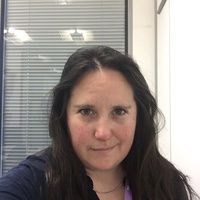
Lecturer
- Email Address
- tara.sutherland@abdn.ac.uk
- Office Address
- School/Department
- School of Medicine, Medical Sciences and Nutrition
Biography
I graduated with a BSc with Honours degree from the University of Melbourne in Australia before embarking on PhD in Pharmacology studying oestrogen metabolites in cancer using breast tumour models. After a stint studying ligand-receptor modelling at Monash University, I moved to Edinburgh to begin learning all about immunology and how the lung responds to infections, allergens and injury.
I obtained an Asthma UK and Medical Research Fellowship and moved to the University of Manchester to develop and utilise models of allergic airway pathology to study immune responses and extracellular matrix remodelling in the lung. Now in 2022, I am excited to have joined the University of Aberdeen as a Lecturer and will continue to build my research group with the aims of uncovering key immuno-matrix networks that drive lung disease.
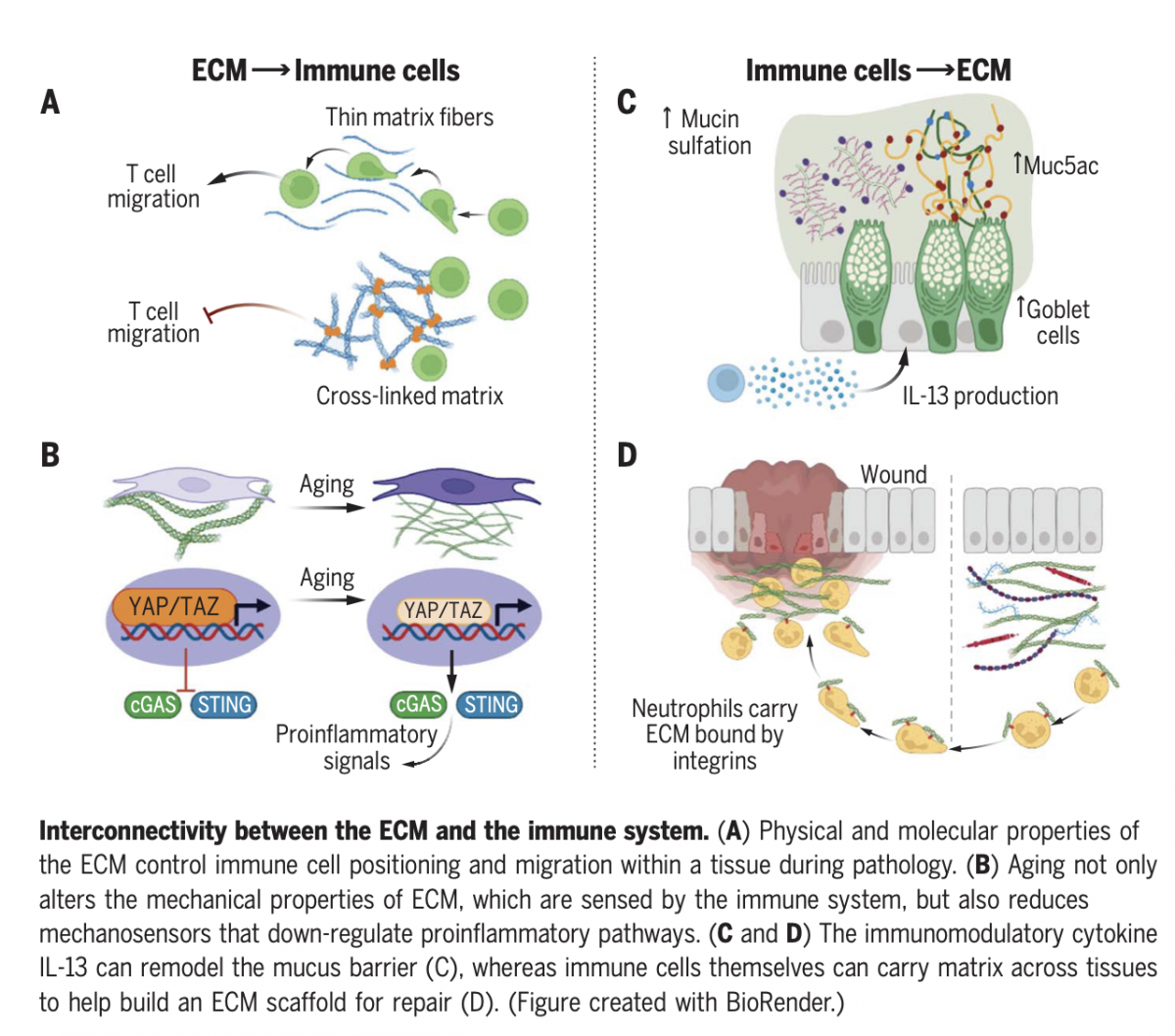
The extracellular matrix and the immune system: A mutually dependent relationship
The extracellular matrix is a key for not only providing structural support for tissues, but also has many essential biological functions, including regulation of immune cell movement, function and survival. In this review, just out in Science, we explore the intimate connections between the matrix and the immune system highlighting examples of where this relationship is key for maintaining health and regulating ageing and disease.
Latest Publications
Extracellular matrix phenotyping by imaging mass cytometry defines distinct cellular matrix environments associated with allergic airway inflammation
Parkinson, J. E., Ghafoor, M., Dodd, R. J., Tompkins, H. E., Fergie, M., Rattray, M., Allen, J. E., Sutherland, T. E.Other Contributions: Other Contributions- [ONLINE] DOI: https://doi.org/10.1101/2024.11.15.623782
Injury From Nematode Lung Migration Induces an IL-13-Dependent Hyaluronan Matrix
Dodd, R., Moffatt, D., Vachiteva, M., Parkinson, J. E., Chan, B., Day, A. J., Allen, J. E., Sutherland, T.Proteoglycan Research, vol. 2, no. 4, e70012Contributions to Journals: ArticlesIL-13 MODULATES THE HYALURONAN MATRIX FOLLOWING INJURY BY THE LUNG MIGRATING NEMATODE NIPPOSTRONGYLUS BRASILIENSIS
Sutherland, T.Proteoglycan ResearchContributions to Journals: ArticlesThe IL-17A-neutrophil axis promotes epithelial cell IL-33 production during nematode lung migration
Ajendra, J., Papotto, P. H., Parkinson, J. E., Dodd, R. J., Bombeiro, A. L., Pearson, S., Chan, B. H., Ribot, J. C., McSorley, H. J., Sutherland, T. E., Allen, J. E.Mucosal Immunology, vol. 16, no. 6, pp. 767-775Contributions to Journals: ArticlesAllergen-induced airway matrix remodelling in mice can be prevented or reversed by targeting chitinase-like proteins
Parkinson, J. E., Adamson, A., MacDonald, A. S., Allen, J. E., Sutherland, T. E.Working Papers: Preprint Papers- [ONLINE] DOI: https://doi.org/10.1101/2023.08.18.553857
Research Overview
Communication between the extracellular matrix and immune cells
controls the tipping point between lung health and diseaseThe extracellular matrix (ECM) is the non-cellular part in all tissues and organs and is made up of molecules like glycosaminoglycans & proteoglycans (e.g. hyaluronan, chondroitin sulfate, heparin sulfate), fibrous proteins (e.g. collagen, elastin) and mucins. More than just physical architectural scaffold within our tissues, the matrix is biologically active with many functions including the ability to direct cell migration and influence cell function. In turn, tissues and immune cells provide critical cues that work together to maintain a healthy tissue matrix. However, if communication and interactions between the matrix and cells is compromised in light of infections, injury, inflammation or insults tissue pathology ensues.
Immuno-matrix in lung health and disease
My lab is focussed on understanding the cross-regulatory pathways between immune cells, stromal cells (e.g fibroblasts) and the matrix that determines the balance between health and disease in the lungs. In order to study these aspects of our research we need to be able to observe what is going on in the tissue microenvironment and therefore our research heavily features high dimensional imaging and analysis (below), and spatial technologies.
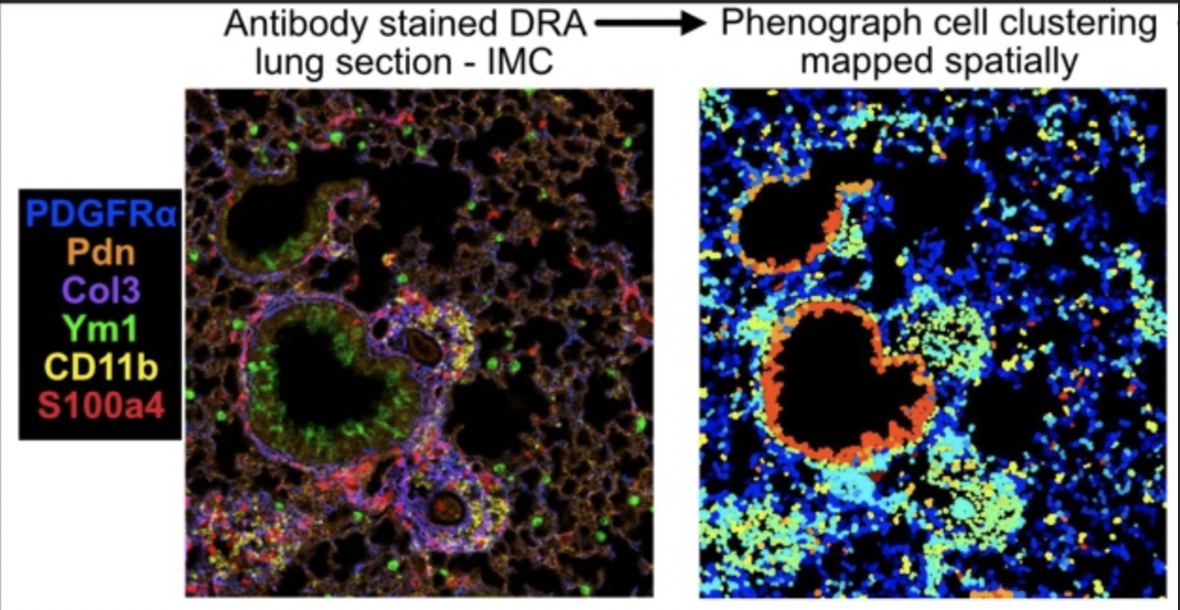
Hyperion imaging mass cytometry – mouse lung stained with a panel of matrix, immune and stromal cell markers. Single cell clustering allows for analysis of cell-cell and cell-matrix interactions spatially in the lung
Research Areas
Accepting PhDs
I am currently accepting PhDs in Biomedical Sciences.
Please get in touch if you would like to discuss your research ideas further.
Research Specialisms
- Allergy
- Biological Sciences
- Biomedical Sciences
- Immunology
- Pathology
Our research specialisms are based on the Higher Education Classification of Subjects (HECoS) which is HESA open data, published under the Creative Commons Attribution 4.0 International licence.
Current Research
Having recently moved my lab to Aberdeen from the University of Manchester, I continue to work with my PhD students and PDRA on collaborative projects primarily based in Manchester, as well as setting up exciting new research here in Aberdeen.
Role of chitinases during fungal host-defence in the lung
One family of molecules that appear crucial in maintaining tissue health through balancing immune responses and remodelling of the extracellular matrix are the chitinases and chitinase-like proteins (CLPs). Chitinases act as host-defence enzymes through their ability to degrade chitin and chitin-containing pathogens (e.g. fungi, parasites, allergens). In collaboration with Prof Munro’s lab in Aberdeen we are looking at how chitinases influence host defence against fungal pathogens in 3D lung cultures – PhD Opportunity.Pathological matrix remodelling in asthma: role for chitinase-like proteins, innate immune cells and fibroblasts
CLPs are derived from chitinase gene duplication but have lost enzymatic activity throughout the evolutionary process. Research is still trying to piece together the functions of CLPs but we know they are highly secreted in inflammation, tissue injury and repair, infections and fibrosis. We revealed the ability of CLPs to regulate immune responses and the ECM in the lung during parasite infections1,2. Now we are investigating how CLPs influence the matrix and immune cell cross-talk in asthma using in vivo mouse models, human lung tissue resections and in vitro assays3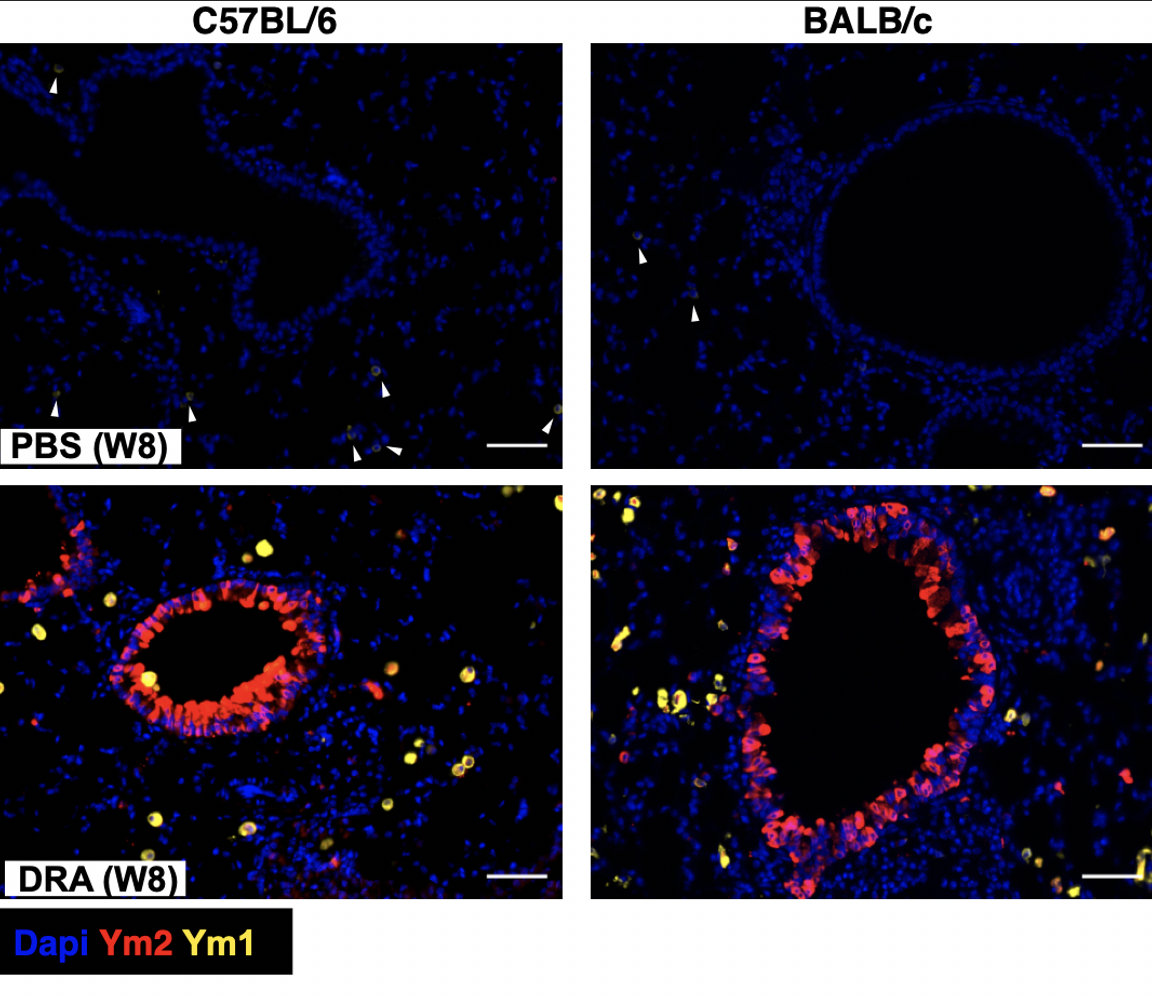
Increased expression of murine CLPs Ym1 and Ym2 following chronic administration of a cocktail of allergens (DRA). Parkinson et al (2021) Immune Cell Biol
IL-13-hylauronan axis during viral infections in the lung
The type 2 arm of the immune response is associated with both helminth infections and allergic inflammation but also critical in orchestrating tissue repair and fibrosis. However, in collaboration with the University of Virginia and University of Manchester, we recently found that type 2 cytokine IL-13 as a driver of severe COVID-19 pathology through regulation of ECM component hyaluronan4. Currently, we are trying to mechanistically understand the IL-13-hyaluronan axis in the lungs, and why this pathway is important in pulmonary diseases.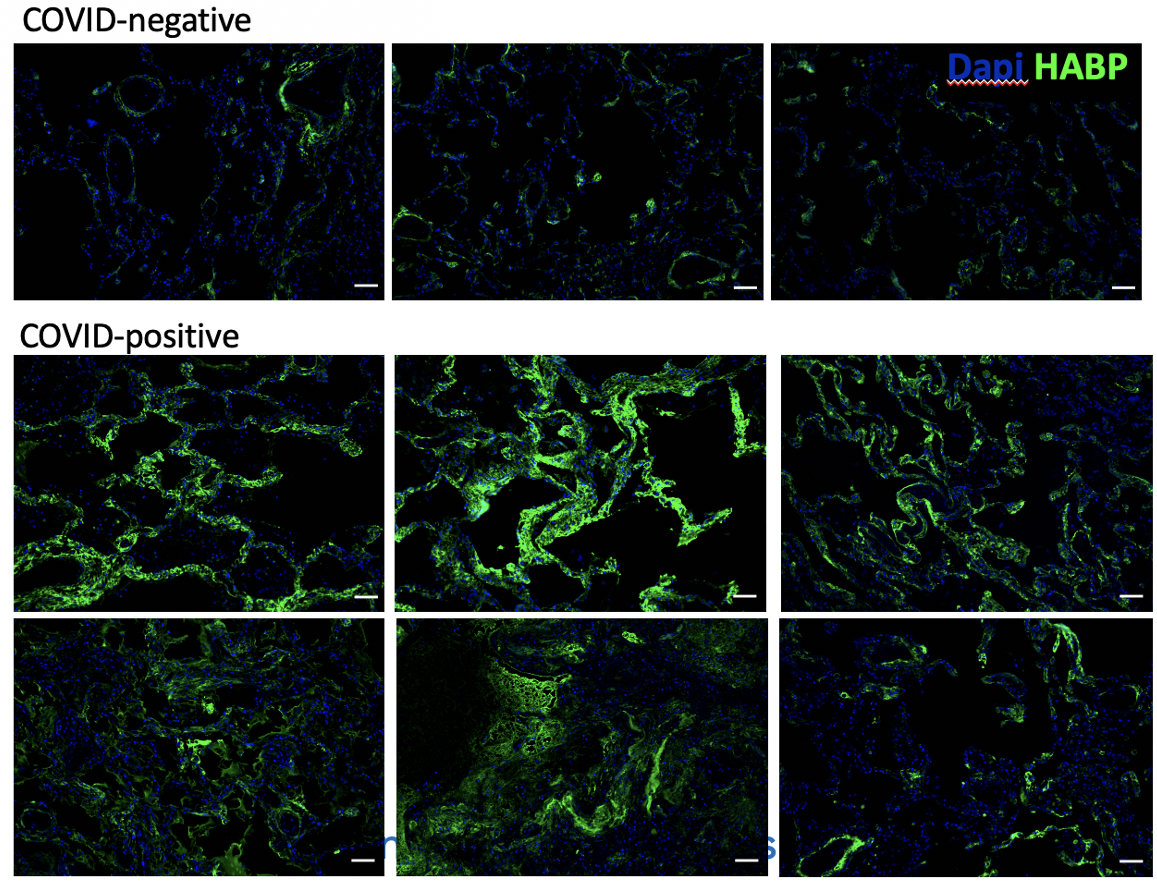
Immunostaining for hyaluronan (green) in the lungs from patients with or without COVID-19. Donlan et al (2021) JCI Insights.
Relevant References
1. Sutherland et al, Chitinase-like proteins promote IL-17-mediated neutrophilia in a trade-off between nematode killing and host damage. Nat Immunol; 15(12), 1116-25 (2014)2. Sutherland et al, Ym1 induces RELMα and rescues IL-4Rα deficiency in lung repair during nematode infection (2018) PLoS Path;14(11)e1007423.
3. Parkinson et al The magnitude of airway remodelling is not altered by distinct allergic inflammatory responses in BALB/c vs C57BL/6 mice, but matrix composition differs. (2021) Immunol Cell Biol 99(6):640-655
4. Donlan et al. IL-13 is a driver of COVID-19 severity. JCI Insight; 6(15):150107 (2021)
Supervision
My current supervision areas are: Biomedical Sciences.
Currently supervise a Wellcome Trust Immuno-matrix in complex disease PhD student based at the University of Manchester studying immuno-matrix in asthma and a student examining the role of the pleural cavity in allergic airway inflammation.
I also co-supervise various PhD students (University of Manchester) in projects surrounding inflammation in the sinus node and lymphoid tissue
Page 4 of 5 Results 31 to 40 of 42
Chitinase-like proteins promote IL-17-mediated neutrophilia in a tradeoff between nematode killing and host damage.
Sutherland, T., Logan, N., Ruckerl, D., Humbles, A. A., Allan, S., Papayannopoulos, V., Stockinger, B., Maizels, R. M., Allen, J.Nature Immunology, vol. 15, no. 12, pp. 1116-1125Contributions to Journals: Articles- [ONLINE] DOI: https://doi.org/10.1038/ni.3023
Host protective roles of type 2 immunity: parasite killing and tissue repair, flip sides of the same coin.
Allen, J., Sutherland, T.Seminars in Immunology, vol. 26, no. 4, pp. 329-340Contributions to Journals: Articles- [ONLINE] DOI: https://doi.org/10.1016/j.smim.2014.06.003
Virus-helminth coinfection reveals a microbiota-independent mechanism of immunomodulation
Osborne, L. C., Monticelli, L. A., Nice, T. J., Sutherland, T., Siracusa, M. C., Hepworth, M. R., Tomov, V. T., Kobuley, D., Tran, S. V., Bittinger, K., Bailey, A. G., Laughlin, A. L., Boucher, J., Wherry, E. J., Bushman, F. D., Allen, J., Virgin, H. W., Artis, D.Science, vol. 345, no. 6196, pp. 578-582Contributions to Journals: Articles- [ONLINE] DOI: https://doi.org/10.1126/science.1256942
- [ONLINE] View publication in Scopus
Induction of IL-4Rα-dependent microRNAs identifies PI3K/Akt signaling as essential for IL-4-driven murine macrophage proliferation in vivo.
Ruckerl, D., Jenkins, S. J., Laqtom, N. N., Gallagher, I. J., Sutherland, T., Duncan, S., Buck, A. H., Allen, J.Blood, vol. 120, no. 11, pp. 2307-2316Contributions to Journals: Articles- [ONLINE] DOI: https://doi.org/10.1182/blood-2012-02-408252
Suppression of type 2 immunity and allergic airway inflammation by secreted products of the helminth Heligmosomoides polygyrus: Immunomodulation
McSorley, H. J., O'Gorman, M. T., Blair, N., Sutherland, T. E., Filbey, K. J., Maizels, R. M.European Journal of Immunology, vol. 42, no. 10, pp. 2667-2682Contributions to Journals: Articles- [ONLINE] DOI: https://doi.org/10.1002/eji.201142161
- [ONLINE] View publication in Scopus
Analyzing airway inflammation with chemical biology
Sutherland, T., Andersen, O. A., Betou, M., Eggleston, I. M., Maizels, R. M., van Aalten, D., Allen, J.Chemistry & Biology, vol. 18, no. 5, pp. 569-579Contributions to Journals: ArticlesAnimal models of airway inflammation and airway smooth muscle remodelling in asthma
Allen, J. E., Bischof, R. J., Sucie Chang, H., Hirota, J. A., Hirst, S. J., Inman, M. D., Mitzner, W., Sutherland, T.Pharmacology & Therapeutics, vol. 22, no. 5, pp. 455-465Contributions to Journals: Articles- [ONLINE] DOI: https://doi.org/10.1016/j.pupt.2009.04.001
Chitinases and chitinase-like proteins: potential therapeutic targets for the treatment of T-helper type 2 allergies
Maizels, R. M., Sutherland, T., Allen, J. E.Clinical & experimental allergy, vol. 39, no. 7, pp. 943-955Contributions to Journals: Articles- [ONLINE] DOI: https://doi.org/10.1111/j.1365-2222.2009.03243.x
Resistance of fibrogenic responses to glucocorticoid and 2-methoxyestradiol in bleomycin-induced lung fibrosis in mice
Langenbach, S. Y., Wheaton, B. J., Fernandes, D. J., Jones, C., Sutherland, T. E., Wraith, B. C., Harris, T., Schuliga, M. J., McLean, C., Stewart, A. G.Canadian Journal of Physiology and Pharmacology, vol. 85, no. 7, pp. 727-738Contributions to Journals: Articles- [ONLINE] DOI: https://doi.org/10.1139/Y07-065
2-Methoxyestradiol - a unique blend of activities generating a new class of anti-tumour/anti-inflammatory agents
Sutherland, T. E., Anderson, R. L., Hughes, R. A., Altmann, E., Schuliga, M., Ziogas, J., Stewart, A. G.Drug Discovery Today, vol. 12, no. 13-14, pp. 577-584Contributions to Journals: Articles- [ONLINE] DOI: https://doi.org/10.1016/j.drudis.2007.05.005
